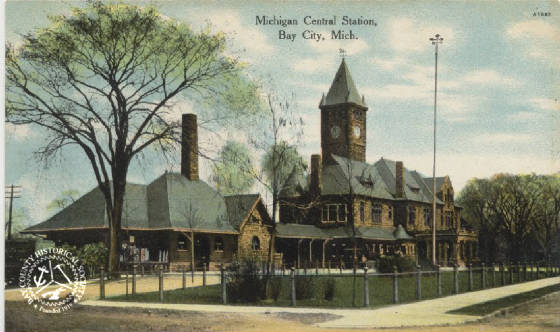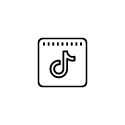by David Hohenstein

Image Source: Bay County Historical Society
Columbia, Spirit of America
Beginning
in the colonial days of the United States of America, as we now know it , the spirit of the Country was seen as something
wild and “uncivilized”. The Land was “New”, “Undiscovered” and untamed; full of beauty,
bounty and mystery. It was just being born, formed out of the rejection of Olde Europe and the quest for freedom and
new beginnings. Out of the clash between an ancient and diverse people’s culture and people from practically another
world.
In those times the image for this new Spirit of the Nation was a goddess. Not a cantankerous Uncle
Sam and before Lady Liberty, her name was Columbia - the rebellious Spirit of this new America. Conceived in poetry and named
in close relation to Christopher Columbus, Columbia was a feminine counterpoint, the daughter of the Old and the mother of
the New. Her image is the symbol for American ideals, her likeness similar to that of the Greek Goddess Athena or the heroic
Lady Liberty of French imagination by Eugene Delacroix. Her image and name are repeated throughout US history in wartime imagery
and iconography, and the name has been passed down in the Nation’s Capital as well as our cinema and music companies.
She lives in many works of art throughout history and in the minds & hearts of our predecessors.
Image Source:
Bay County Historical Society
In the Bay County Historical Museum collection there are multiple examples of her image and role she plays in American
culture, memory and art. Columbia Gives her Son the Accolade of the New Chivalry of Humanity is one such example. Commissioned
by former President Woodrow Wilson and designed by the acclaimed artist Edwin Howland Blashfield in 1919, it is a memorial
and honor to those who were wounded or killed while serving in battle during the First World War. In it Columbia stands centered
in a ceremonial service with a massive star-spangled banner billowing behind her. In one hand she holds aloft a proclamation
document, and in the other an elegant and severe sword. With the weapon placed gracefully on a kneeling soldier's shoulder
she acknowledges and knights him. The soldier takes a knee before the barefooted vision and looks into her eyes from below
the brow of his steel helmet. He is dressed in a full field uniform with his rifle in hand while the ranks of his brothers
in arms stand in solidarity and witness behind them. Blashfield’s rendition is an example of a master artist at the
height of his talents, one with a keen understanding of medium, realism, composition and symbolism. This image would be copied
and dispersed to thousands of Americans and soon after be adopted as the seal of the Disabled American Veterans Organization
in 1920.
The Artist
Edwin H. Blashfield was born in New York in the year 1848
and lived until 1936. During his lifetime he studied and practiced Art in America and Europe, earning degrees and awards from
some of America’s finest Art Institutions. He studied at the Pennsylvania Academy of Fine Arts and afterwards traveled,
worked and exhibited throughout the United States and Europe. He learned from academic traditions and honed his skills and
expertise in easel and mural painting.
Blashfield’s murals decorate numerous American institutions including
the Wisconsin, Iowa and Minnesota capitol buildings, the Detroit Public Library, the Library of Congress in Washington D.C.
as well as churches in Washington D.C. and New York. He was awarded an Honorary Doctorate of Fine Arts by New York University
and served as President of the National Society of Mural Painters. He authored the book “Mural Painting in America”
(1913) which was a compilation of lectures he gave expounding his knowledge and insight of mural painting.
Blashfield drew this image of “Columbia” and “Her Son" and from the original artwork a print plate
was made. To do this the drawing would have been photographed and with the negative the image would be etched into a copper
plate. Using light exposure and a photosensitive coating, the impression is made chemically - changing the surface of the
plate. Once the plate was prepared, printing was accomplished in the traditional manner. The resulting image is referred to
as a photogravure. In this way the drawing was reproduced efficiently in mass and the copies made out to veterans by inscribing
the individual's name in the allotted space. Sometimes copies like these are referred to as “broadsides” - a term
from earlier mechanical printing days meaning one side of a sheet of paper was printed on. These could be widely reproduced
at low cost and often used as advertising, posters and ephemeral art. E. H. Blashfield’s design went beyond a marketing
or advertising tool and became a piece of art, dedicated to the many wounded and fallen soldiers he aimed to honor.
The Soldiers
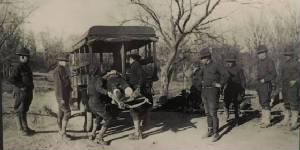
Image Source: Bay County Historical Society
From 1914 - 1918, Europe waged the First World War. After
several years of intense fighting, American President Woodrow Wilson agreed to send his troops abroad to combat the Axis powers.
Men from the Michigan and Wisconsin National Guard were called to service as part of the American Expeditionary Forces in
1917, making up infantry and ambulance units. They were sent first to Waco Texas for training and arrived in France in early
1918. These Midwestern Recruits formed what was called the “Red Arrow Division” and nicknamed “Les Terribles”
by the French. Their fighting was furious enough to conquer twenty-three German divisions in French territory, after which
they captured their opponents as well as their weapons, ammunition and artillery. They fought in three major battles, gained
back the French ground, and became the first American soldiers to set foot in German soil during the conflict.
To
those who survived the battles and the influenza pandemic, many were left maimed with wounds to their bodies and minds. New
inventions for human slaughter resulted in casualties that reached into the millions. It was named the “War to end wars”,
but in many ways it ushered in a new era of war on our planet. In Columbia Gives her Son the Accolade of the New Chivalry
of Humanity it seems the title is chosen as something hopeful. Columbia, the Mother of all Americans, knights her Son to bestow
on him honor, victory and gratitude. She is electing him the status of a heroic and humble warrior. With this commemorative
art, it is a gesture of recognition and respect to all those soldiers who fought and died hoping for a better world. The work
recalls the highly refined Classical style and with that harkens Nobility. It is the nobility of each common person who fought
this war and gave their lives and limbs, enduring treacherous conditions and terrible danger. It elects them all to the status
of knights as they each played their part in a hard won victory.
Sources:
Bay
County Historical Society Exhibit “Trails Through Time: Bay County Boys, Les Terribles, The 128th Ambulance Corp”
“Artists - Edwin H. Blashfield, American 1848-1946” Le Trianon Fine Art and Antiques. 2018
https://www.letrianonantiques.com/fine-art/artist-detail/edwin-h.-blashfield
“Broadside
(printing)” Wikipedia The Free Encyclopedia. February 6, 2023.
https://en.wikipedia.org/wiki/Broadside_(printing)
“Edwin Blashfield” Wikipedia The Free Encyclopedia. March 17, 2023.
https://en.wikipedia.org/wiki/Edwin_Blashfield
“Columbia (personification)” Wikipedia The Free Encyclopedia. May 11, 2023. https://en.wikipedia.org/wiki/Columbia_(personification)
“Columbia Gives to Her Son the Accolade of the New Chivalry of Humanity Anna Cecelia [i.e., Cecilia] Foldese
[i.e., Foldesi], Army Nurse Corps served the honor in the World War and died in the service of her country / designed by E.H.
Blashfield, 1919.” Library of Congress. 2023 https://www.loc.gov/item/2013650540/
“Columbia Gives to Her Son the Accolade of the New Chivalry of Humanity, World War I” Tennessee
Virtual Archive. 2023 https://teva.contentdm.oclc.org/digital/collection/broadsides/id/74/
“Women at the Center; American Woman? Amerique’, Columbia and Lady Liberty” New-York Historical
Society Museum & Library. October 23, 2018. https://www.nyhistory.org/blogs/american-woman-amerique-columbia-and-lady-liberty
Whitaker, Luke. “What is a Photogravure Print?” Bosham Gallery Collect Photography. April 25, 2021
https://boshamgallery.com/blog/29-what-is-a-photogravure-print/
“WWI Memorial Print Columbia Liberty New Chivalry of Humanity Blashfield” The Designers Consignment.
2023. https://thedesignersconsignment.com/product/31220
Photos from BCHS Collection
by Sam Fitzpatrick
Image source: Bay County Historical Society
Bay County's
railroad history can be traced back to 1867 when A. S. Munger constructed a line between Bay City and East Saginaw. Originally,
the marshes and swamps made it impossible to build a railroad in this region. The solution was to dredge a canal along the
route and add clay subsoil to build up the embankment that supported the tracks. Soon both passenger and freight train lines
crisscross Michigan and eventually, the Midwest. People and goods, such as lumber and salt, that were being transported by
boat on the Great Lakes now utilized the rail lines. This mode of transportation was deemed less dangerous.
In 1868, Henry Sage and Charles Fitzhugh were instrumental in extending the Jackson, Lansing, and Saginaw Railroad from
Saginaw to Wenona, Henry Sage’s company town before merging with West Bay City in 1877. This opened a line to a Chicago
connection. In 1871, the Jackson, Lansing, and Saginaw Railroad line became part of the Michigan Central Railroad (MCRR).
In 1873, this line connected with Detroit through Vassar and became known as the Beeliner. A rail bridge was constructed over
the Saginaw River to connect to Wenona, which can be seen today just north of the Liberty Bridge. In 1930, New York Central acquired a 99-year lease of the Michigan Central System and the ‘Big Four’—Cleveland,
Chicago, Cincinnati & St. Louis Railroad lines.
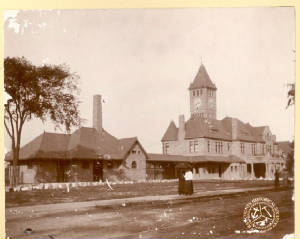
Image source: Bay County Historical Society
Construction on Bay City’s Michigan Central Depot., located at 801 First Street, started in June of 1889 and was
completed in August of 1890. On September 22, 1890, it opened for business. The architectural firm, Spier and Rohns of Detroit,
built it in the Romanesque style, and it was considered an architectural jewel. It cost $65,000 to build and occupied two
blocks encompassing Van Buran, First, Monroe Streets, and the railroad tracks. The depot was constructed of Indiana Vermillion
sandstone, had an Akron red-stoned roof, and a 104-foot clock tower with a 6’2” clock with faces on all four sides
that illuminated at night. The building was 286 feet long, 50 feet wide, and three stories in height. The foundation was made
of Point au Barque stone and Joliet water table. Indiana Sandstone was used for the baggage claim. It was a separate building
located directly west of the main structure, which still stands at First Street, measuring at 61x36’.
The ceilings were oak, except for red birch in the women’s waiting room and the superintendent’s office.
Some sources mentioned that their reflections could be seen in the wood polish. The south entrance of the building had a semi-circular
driveway extending from Monroe to Van Buren streets. It spanned east to west with a porch supported by Romanesque sandstone
pillars. There was also a walkway from First Street to the main doors.
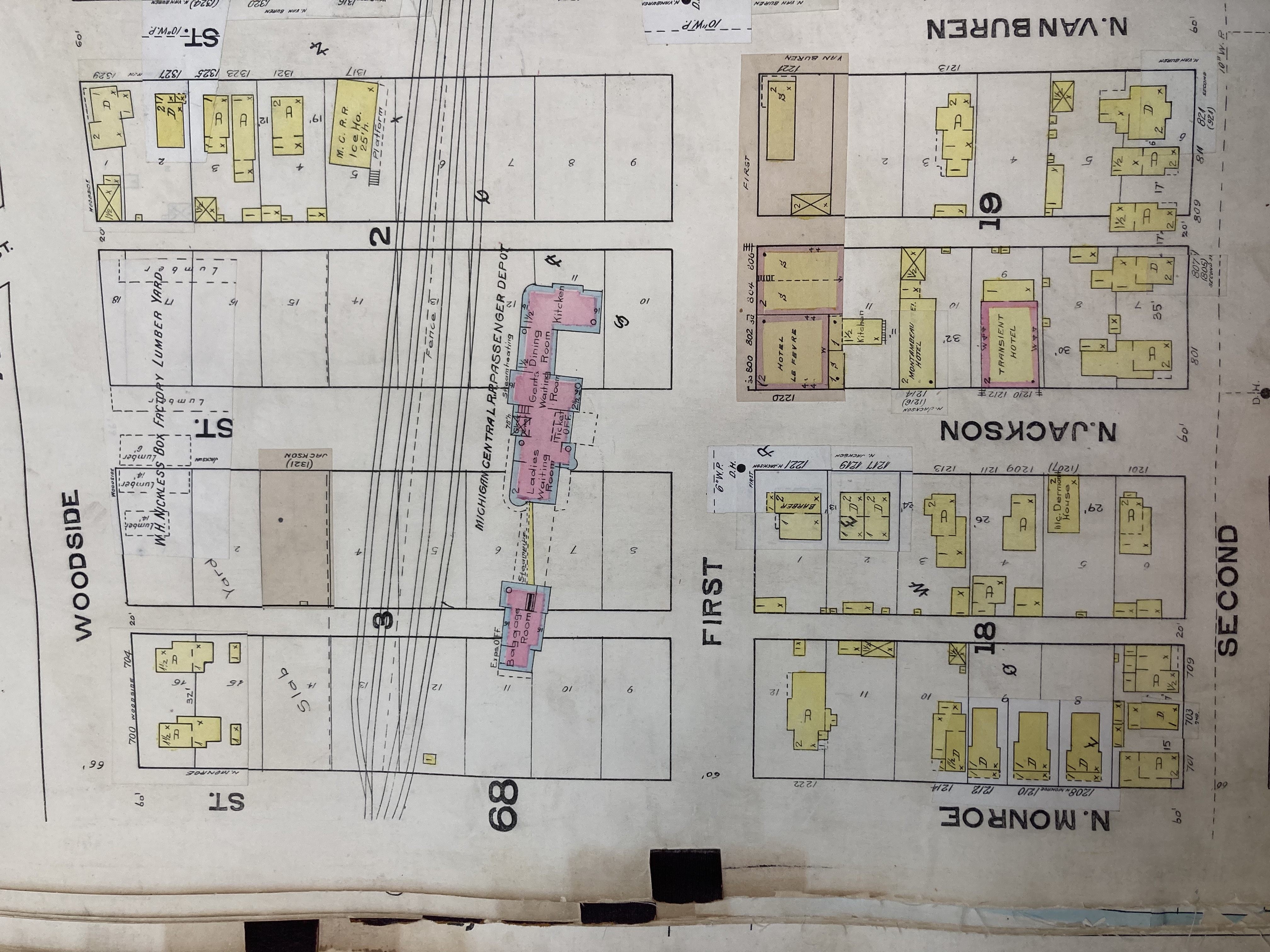
Image source: Sanborn Map, Bay County Historical Society
Inside the main doorway was a 15-foot wide tiled vestibule. The only exit to the outside platform
was located here. Uniformed employees guided travelers to their trains. Between the building and the tracks laid a wooden
plank platform. The women’s waiting room was red birch with pressed brick, a sandstone fireplace, and upholstered furniture.
The gentlemen’s waiting room was oak. Between the waiting rooms was a ticket office. The dining room was located on
the main floor. Each table setting contains a silver-plated monogram “M.C.”. A covered walkway connected the depot
to the baggage and express building. The depot also housed the freight and engineering offices, baggage department, and telegraph
room. At one point, the depot had a staff of over 100 individuals.
A lavish stairway made of
polished oak gave access to the second and third floors. On the second floor's northwest corner was the superintendent's office
with a semi-circular window that looked out to the yard. This floor also contained sleeping quarters for employees. The third
floor featured a private office and drawing room for the civil engineer. The entire depot was heated by hot water and lighted
by incandescent electric lamps. Surrounding the entire property was a cast-iron fence.
During the height of rail travel, the Michigan Central depot was the busiest place in town. The train schedule for the
MCRR ran from 3:45 am until 9 pm. In June of 1907, a total of 24 daily departures and arrivals on the Michigan Central Line
were made at this depot and the west side depot on Marquette; including the Detroit Express, the Chicago Special, Saginaw
Division Local, Mackinaw & Marquette, Duluth Special, Vassar Trains, Saginaw, and Midland Accom.
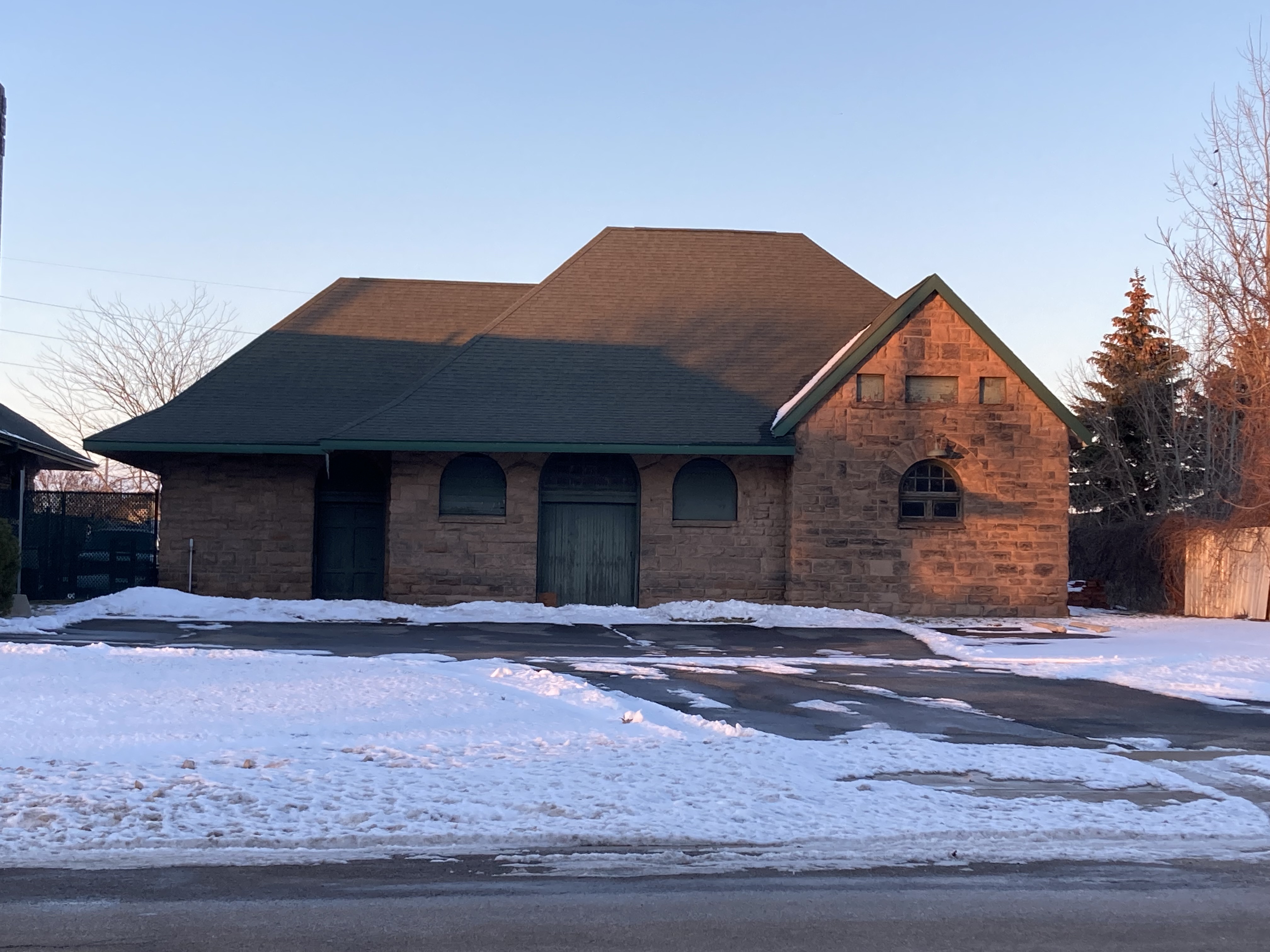
Image source: Present day baggage department. Taken by Sam Fitzpatrick,
2021
The depot remained busy until after World War II. Rail travel saw a decline with the
growing popularity of air travel and the affordability of automobiles. The depot closed in 1958, transitioning service to
the west side depot on Marquette Avenue.
The vacant building suffered fires in 1948 and 1963.
The cause of the first fire was the result of defective wiring on the third floor. The second fire was started by children
who ignited paper stuffed in rafters. In 1964, the building was razed to make way for a warehouse for Northern Tobacco and
Candy Company. The same week it came down, The Beeliner made its last run from the Pere Marquette Depot, marking the end of
96 years of passenger rail travel in Bay County.
Today, all that remains of the former
depot is the baggage building on First Street across from Maplewood Manor and Baytown Family Neighborhood.
Sources:
BCHS Vertical Files
“Era of Passenger Rail Service Fading” Bay City Times. February 23,
1964.
“Retired Railroad
Veterans Looks Back” Bay City Times. February 9, 1964.
“RR
Fans Ride ‘Beeliner’ to Oblivion” Bay City Times. March 22, 1964.
“AND DOWN SHE GOES” Bay City Times. February 20, 1964.
“Railroad Passenger Depot Is a Vanishing American Institution” Bay City Times.
December 27,
1959.
“New Central Depot.” Bay City Times Tribune. June 11, 1890.
“Imposing Edifices” Bay City Tribune. October 11, 1891.
Atlas of Bay City, Mich. Chicago, Il: Published By The Rascher Insurance Map Publishing
Co., 1891.
Michigan’s Railroad History 1824-2014. Lansing, MI. Published by the Michigan Department of Transportation
https://www.michigan.gov/documents/mdot/Michigan_Railroad_History_506899_7.pdf




